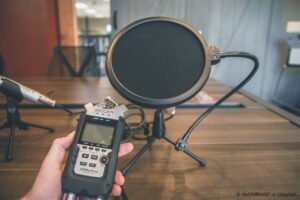
As part of our work on exploring how we communicate emotions, attitudes, motivations, and other social signals through voice cues (for example, pitch, loudness, or speech rate), we have set up this on-line audio recording studio to help us gather a range of different voice files.
In our work, we explore how voice cues are used in different conversations: imagine, for example, someone replying to your question of how they are feeling today with a hesitant, shaky “I’m fine, thank you”. Would you trust that there are saying the truth just as if they had replied to you in a firm, friendly “I’m fine”?
We often underestimate the effect our voice can have on others. Indeed, there’s work that shows that you can make someone feel better by speaking in a positive, encouraging voice. Equally, you can make someone feel unwelcome using voice cues that signal your disinterest in the other person. Knowing more about how voices can affect others can help improve conversations.
Here, you can help us find out more about how voices are used to what effect. If you are interested in participating in one of our studies, please get in touch with us at paulmann(at)essex.ac.uk and we will be happy to tell you what we are working on at the moment.
Prof. Silke Paulmann
